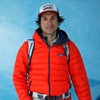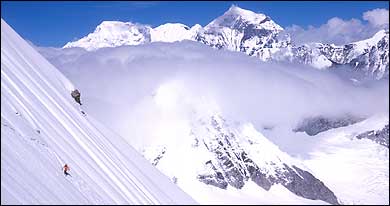║┌┴¤│ď╣¤═°‘s March 2004 article chronicles big-mountain snowboarder Steven Koch’s quest to become the first to summit Everest and then set a never-before-attempted line down its treacherous North Face. Accompanying Koch on the Everest expedition was mountaineer-photographer Jimmy Chin, who captured the powerful images that accompanied the article.
As the story explains, falling debris and dangerous snow conditions forced the expedition to call it quits, but the following is another story┬Śthe one that lives behind each image. Consider the photo above: Leading away from the relative safety of the ridge and out across a sun-weakened avalanche field are Chin’s barely discernable boot tracks. He hiked over Everest’s Japanese Couloir for this shot, putting himself in danger in order to frame Koch against the steep ridgeline. “At that point I shouldn’t have really been screwing around,” Chin says, “but I knew I wanted a shot of him on the ridge, so I traversed way out left. I was really cranking because I knew we didn’t have much time.”
This is the life of an expedition photographer┬Śtaking unseen risks in order to bring the rest of us vicariously along for the ride. In fact, according to Chin, his success as a photographer is due largely to his mountaineering experience, since expeditions prefer to work with someone who won’t become a liability in tough climbing situations. In many cases Chin only has a split second to snap a shot before the opportunity is gone.
Although Chin is considered one of the best expedition photographers working today, he’s far too modest to admit it: “I’m really not technically a very good photographer at all,” he says. “I think most people would be mortified┬Śmost amateur photographers know more than I ever will, mostly because I don’t have time to sit down and read the books.”
Stephen Koch buried both ice axes into the Japanese Couloir moments before the team decided conditions were too treacherous to continue the ascent. Chin was leading the way (you can see his tracks heading away from Koch) and turned to capture Koch in front of this Himalayan backdrop. “There had just been this big discussion. We weren’t where we wanted to be, so I knew this might one of my last chances to get climbing shots,” Chin says.
After returning to base camp, Chin realized that he’d shot with too wide an aperture, exposing the film to too much light. “Because I wasn’t thinking straight and there was a lot going on, I shot that roll at 1/125th of a second and F16. When I got back to base camp I realized I should have used a smaller aperture.” In situations like that, Chin has the lab clip the tail end of the film and test it to determine what compensations will need to be made in the processing. “That was a little stressful,” he says.
This photo of Stephen Koch acclimatizing on Changzheng Peak with Everest in the background is from the same roll as ║┌┴¤│ď╣¤═°‘s March cover image. Barely visible are Chin’s boot tracks leading into the foreground.
“You can set up for all the stuff for days and days and the light just doesn’t happen┬Śthe clouds roll in,” Chin explains. “And then there are days when everything is happening, and you’re in the right place, the light’s there and everything opens up.”
Right before this shot was taken, the sun had just risen over the ridge, creating soft shadows, and Everest lined up unoccluded as a backdrop. “I turned around and fired off almost a whole roll. I knew it was going to be a good one. It’s funny, because however many good moments like that you have, you know you’re going to pay for it somewhere else. I paid for that one later in the year in Africa. I was rigging a climbing shoot for days, getting everything set up and waiting for sunset. I pulled out my camera several thousand feet up on another tower in the middle of Mali and my shutter locked up. I thought, ‘Damn it, I’m paying for that day at Everest.'”
In this shot, Stephen Koch carves turns in the Japanese Couloir with ice axes ready to self-arrest in case he falls. “Even though it’s not that spectacular, it’s one of my favorites. Photgraphers always have a favorite photo from a shoot, though it may not be the best one.”
Koch had just strapped on his board and Chin was only going to get one chance to get what he needed. Chin nailed it with two presses of the shutter button, capturing Koch in an active and well-balanced pose while managing to turn the blinding, high-altitude sun (one of the most difficult factors for a mountain photographer to manage) into a well-composed star. “It was almost an impossible shot. One of the problems with shooting over there is that you are in such a big valley with huge mountains that you never get early morning light. That’s why I shot a lot of sun-flare shots. You just have to work with it. The secret to a good sun flare is to use a high F-stop and be sure not to meter with the sun in the frame.”
Direct sunlight on Everest’s lower reaches provides a white canvas for Stephen Koch’s yawning silhouette. Descending off the right side of the mountain are the Hornbien Couloir and, lower, the Japanese Couloir, Koch’s intended route. “Every morning like clockwork we would get up and check conditions on the mountain. A big part of getting acclimatized is getting to know the mountain┬Śgetting intimate with it. You’ve got to know how the mountain reacts to different types of weather.”
To shoot the silhouette, Chin placed Koch out of the light and metered for the light that was shining on the Mountain. Using a 200-millimeter lens, he compressed the scene so that Koch’s outline seems like part of the mountain.
Everest strikes a pose as storms clear a window for the afternoon light. Chin shot an entire roll of Fuji Velvia 50 in order to get this one just right. “I shot it in a lot of ranges. I shot it really wide and really tight, vertical and horizontal. It’s hard to know what will look best. When the lighting is good like that, you can’t be afraid to burn film.”
Chin also used a tripod which allowed him to make the most of the slow 50-speed film. Velvia offers great color saturation for landscapes, but often requires a slow shutter speed to get enough light onto the film.
A cloud formation hovers over Everest signaling high winds at the summit. Chin and Koch were at Camp I and had just climbed out of their tent. “It’s one of the indicators you use to predict weather. You know the weather is going to either get better, worse or stay the same.”
Once he left base camp, Chin restricted himself to one camera and one lens in order to keep the weight down. In this case, the weapon of choice was a Nikon F100 with a 24-120 millimeter lens. “It’s funny, I hate that lens, but I have to say I’ve shot more published photos with that lens than any other by many multiples. The lens isn’t that clear, but as long as you stay in the mid range, it works fine.”
Here, ice spires seemingly spring from the till at the foot of Everest’s glacier. In reality they are the lowest fingers of the glacier petering out into the valley. Stephen Koch is being belayed by base camp manager Eric Henderson. “It was killer because it was like climbing little ice towers. It was like being in the Needles of South Dakota,” Chin says.
Chin used a polarizer to get more detail and contrast out of the clouds and give the spires an eerie glacial-blue tint. “It’s not like I thought, ‘I’m going to use my special technique.’ It was more like, ‘I thought I read somewhere that you’re supposed to use a polarizer when it’s cloudy.'”
Eric Henderson follows Stephen Koch on a recon tour to the base of Everest. The climbers needed to get a feel for the terrain, see how long it would take to get to the route, and scout for any unseen crevasses. Though on a photo-assignment, Chin always puts the grunt work first. “I’m there climbing. The photography thing is totally separate. You have to climb and do all of the training and the technical stuff. That can never be compromised. You have to do all of that, then you can think about photography. If I can’t hike or ski or climb, then I can’t be there to shoot.”
A zebra-striped gully dwarfs Stephen Koch on an acclimatization tour near base camp. “It was a huge maze-Lord of the Rings style. We were constantly getting lost, looking for a route to the peak we were trying to climb. It was pretty entertaining really.”
In order to get the shot, Chin had to get out ahead of the expedition, something he has to do often. Despite the apparent irony of shooting explorers following the track he has just cut, Chin maintains that his job is to document. “Some people don’t want to share their story. But if there’s a story they want to tell, the photographer’s job is to bring back the story.”


